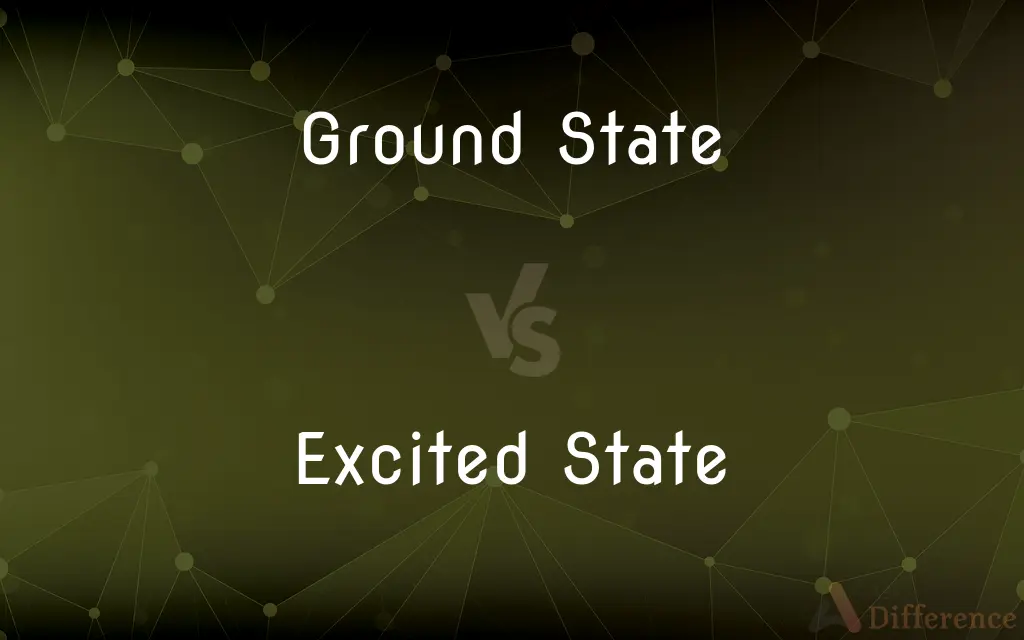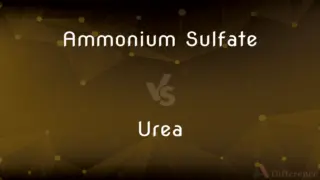Ground State vs. Excited State — What's the Difference?
By Tayyaba Rehman — Published on November 15, 2023
Ground state is an atom's lowest energy level, while excited state is a higher energy level achieved when an atom absorbs energy.

Difference Between Ground State and Excited State
Table of Contents
ADVERTISEMENT
Key Differences
In the realm of quantum mechanics, the ground state represents the lowest energy level in which an atom or molecule can exist. It's the default state, meaning it's where atoms are when they're not being energized. In contrast, the excited state describes an atom or molecule that has absorbed energy and has moved to a higher energy level.
When an atom is in its ground state, it's at its most stable. This means it hasn't absorbed external energy or been agitated to shift its electrons to higher energy orbits. However, when an atom absorbs energy, such as from light, it can shift to the excited state. This state is temporary, and atoms tend to return to the ground state by releasing the absorbed energy.
The transition between the ground state and the excited state is fundamental in many physical processes. For instance, when you see colors, it's because certain materials absorb specific wavelengths of light, pushing their atoms from the ground state to the excited state. As these atoms revert to the ground state, they release energy in the form of light, which we then perceive as color.
Moreover, the energy difference between the ground state and the excited state determines many properties of materials, like their color or their reactivity. In the vast cosmos of atomic interactions, the dance between these two states plays a crucial role. While the ground state is where atoms prefer to be, the excited state is where a lot of the action happens in terms of chemical reactions and other phenomena.
In essence, the ground state and the excited state are two sides of the same coin. One represents stability and the natural state of atoms, while the other showcases the dynamic nature of atoms when they interact with energy.
ADVERTISEMENT
Comparison Chart
Energy Level
Lowest energy level
Higher than ground state
Stability
Most stable state
Temporary and less stable
Result of
Natural state of atom/molecule
Absorption of energy
Role in Light Absorption
Atoms are often in this state before light absorption
Atoms move to this state after light absorption
Duration
Indefinite until energy is absorbed
Temporary, until energy is released
Compare with Definitions
Ground State
Default state of an atom or molecule.
Without external energy, atoms naturally exist in the ground state.
Excited State
Result of energy absorption.
Atoms jump to the excited state when they soak up energy from light.
Ground State
Represents no extra energy absorption.
Before absorbing light, a metal's electrons are in the ground state.
Excited State
Temporary and less stable than ground state.
After a brief moment in the excited state, atoms usually release energy and return to the ground state.
Ground State
The lowest energy state of an atom.
Hydrogen's electron is in the ground state when it occupies the first energy level.
Excited State
A higher energy level of an atom than its ground state.
When a hydrogen atom absorbs energy, its electron moves to an excited state.
Ground State
Most stable energy level.
Atoms prefer the ground state as it's their most stable configuration.
Excited State
Where electrons move upon agitation.
Bright light can push an atom's electrons into the excited state.
Ground State
Where electrons are without external agitation.
In the dark, atoms of a material are mostly in the ground state.
Excited State
Represents energy elevation in an atom.
Fluorescent materials glow because their atoms move to the excited state and then release light when returning to the ground state.
Common Curiosities
What happens when an atom goes to the excited state?
In the excited state, an atom has absorbed energy, elevating its electrons to higher energy levels.
What is the ground state in atomic terms?
The ground state is the lowest and most stable energy level of an atom.
Is the ground state more stable than the excited state?
Yes, the ground state is more stable and is the natural state of an atom.
Is the transition between ground and excited states crucial in chemical reactions?
Yes, these transitions are fundamental in various physical and chemical processes.
Can an atom remain in the excited state indefinitely?
No, the excited state is temporary; atoms eventually release energy and return to the ground state.
How do atoms return from the excited state to the ground state?
Atoms release the absorbed energy, often as light, to return to the ground state from the excited state.
What's the significance of the energy difference between the ground and excited states?
This energy difference determines properties like material color and reactivity.
Can multiple excited states exist for an atom?
Yes, an atom can have several excited states, each representing a different energy level above the ground state.
What causes an atom to transition from the ground state to the excited state?
External energy, like light or heat, can cause an atom to transition from the ground state to the excited state.
Does the excited state play a role in color perception?
Yes, when materials absorb certain light wavelengths and their atoms transition to the excited state, they emit light upon returning to the ground state, which we perceive as color.
Share Your Discovery

Previous Comparison
Ammonium Sulfate vs. Urea
Next Comparison
Personal Communication vs. Impersonal CommunicationAuthor Spotlight
Written by
Tayyaba RehmanTayyaba Rehman is a distinguished writer, currently serving as a primary contributor to askdifference.com. As a researcher in semantics and etymology, Tayyaba's passion for the complexity of languages and their distinctions has found a perfect home on the platform. Tayyaba delves into the intricacies of language, distinguishing between commonly confused words and phrases, thereby providing clarity for readers worldwide.












































